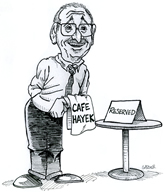Unsurprisingly, Arnold Kling’s take on Greg Ip’s take on China’s effect on the global economy is sound. A slice:
Our ability to produce and consume goods and services depends on our productivity. China does not affect that. China can affect the mix of goods and services that we produce. If it sells us some stuff at below cost, we can say “thank you” and produce something else instead.
As long as we are looking only at our consumption opportunities, trade is positive sum. If China wants to sell us stuff below cost, that hurts them and helps us.
The Editorial Board of the Washington Post reveals “the lunacy of asking tourists to turn over their social media history.” A slice:
America’s closest allies are among the 42 countries in the visa waiver program whose visitors would now be subject to these checks. Not only does this seem impractical, creating unnecessary red tape for our friends to navigate when coming to America. It also cedes the free-speech high ground. Can the U.S. inveigh against the U.K. arresting an Irish comedian for his tweets or South Korea enacting “disinformation laws” when it also treats speech as dangerous?
It’s certainly not going to help tourism. Hospitality industry leaders complain they weren’t consulted before the new rule was proposed in the Federal Register, which kicked off a 60-day period for public comment. The agency responds that this is just “the first step in starting a discussion.” If the administration is so interested in reading what foreigners have to say on social media, they should heed the complaints from people across the world who fear old Facebook posts could prevent them from getting to see the World Cup next year.
Ramesh Ponnuru explains that, on the question of birthright citizenship in the U.S., “the president and his allies are … wrong about the Constitution.” A slice:
The meaning of a law is, in the first place, not limited to what its authors mainly had in mind. The equal protection clause, also in the 14th Amendment, was motivated principally to ensure that state governments protected ex-slaves. Because it was written in general language, though, it extends to other groups and it doesn’t apply only to racial discrimination.
Here’s the speech that María Corina Machado would have personally delivered had she – the 2025 winner of the Nobel Peace Prize – been able to get to Oslo in time. Two slices:
Meanwhile, something deeper and more corrosive took place. It was a deliberate method: to divide society by ideology, by race, by origin, by ways of life; pushing Venezuelans to distrust one another, to silence one another, to see enemies in one another. They smothered us, they took us prisoners, they killed us, they forced us into exile.
It had been almost three decades of fighting against a brutal dictatorship.
And we had tried everything: dialogues betrayed; protests of millions, crushed; elections perverted.
Hope collapsed entirely, and belief in any kind of future became impossible. The idea of change seemed either naive or crazy. Impossible.
Yet, from the very depths of that despair, a step that seemed modest, almost procedural, unleashed a force that changed the course of our history.
We decided, against all odds, to run a primary election. An unlikely act of rebellion. We chose to trust the people.
To rediscover one another, we traveled by road and by dirt path in a country with gasoline shortages, daily blackouts, and collapsing communications.
Forbidden from advertising, without money or media willing to speak our names, we crossed it armed only with conviction.
Word of mouth was our network of hope, and it spread faster than any campaign. Because our desire for freedom was very much alive within us.
…..
Our political prisoners, the persecuted, their families, and all who defend human rights; those who sheltered us, fed us, and risked everything to protect us; the journalists who refused silence, the artists who carried our voice; my exceptional team, my mentors, my fellow political and social activists; the leaders around the world who joined and defended our cause; my three children, my adored father, my mother, my three sisters, my brave and loving husband, who’ve all supported me throughout my life; and above all, the millions of anonymous Venezuelans who risked their homes, their families, and their lives out of love.
To them belongs this honor.
To them belongs this day.
Peter Savodnik reports on “the revenge of the climate realists.” A slice:
Of course, [Michael] Shellenberger said, the decline of climate alarmism does not mean the decline of alarmism. We had segued seamlessly from the Cold War–era fear of nuclear war to the fear of overpopulation to the fear of climate change.
And now?
“Now, it’s probably going to be AI security,” [Steven] Koonin said. “That’s a big one. Or maybe microplastics. It could definitely be microplastics.”
It did not help that we inhabited a supremely political moment, [Roger] Pielke said. The polarization, the anger, the constant ratcheting up of our emotions—it made us more susceptible to other people’s moral crusades.
“I would not expect a reckoning,” Pielke added.
The Editorial Board of the Wall Street Journal applauds the exposure of some faulty climate ‘science.’ A slice:
Still other scientists in August noted in a comment that “data anomalies arising from one country” in the “underlying GDP dataset, Uzbekistan, substantially bias their predicted impacts of climate change.” When the Uzbekistan data was removed and statistical uncertainty corrected for, the results were no longer “statistically distinguishable from mitigation costs at any time this century.”
In other words, the economic harm from climate change no longer exceeded the costs of the government interventions to do something to arrest warming temperatures.
The study had so many errors that Nature has now retracted it, but what an embarrassment. “Post-publication, the results were found to be sensitive to the removal of one country, Uzbekistan, where inaccuracies were noted in the underlying economic data for the period 1995–1999,” the retraction says.
The retraction is also a black eye for the Network for Greening the Financial System, a group of central banks and financial regulators that incorporated the study’s projections into its bank climate stress test scenarios. The Federal Reserve belonged to the network until Chair Jerome Powell withdrew in January.
One question is why the study’s glaring errors weren’t caught by peer reviewers before it was published. One culprit might be conformity bias, as reviewers didn’t want to gainsay findings that support the narrative that humanity is killing the planet and the entire world economy must be rearranged to prevent it. When politics is in the saddle, the chances of bad science increase.
If progressives want to know why so many Americans don’t believe claims of the climate apocalypse, it’s because so much of climate science has been shown to be unbelievable.
Eric Rasmusen accuses the American Economic Association of hypocrisy.
My GMU Econ colleague Mark Koyama reviews W. Walker Hanlon’s The Laissez Faire Experiment.
Responding to a context-less – and, hence, misleading – tweet by E.J. Antoni, Ph.D., GMU Econ alum Jeremy Horpedahl tweets: (HT Scott Lincicome)
A Big Mac was $2.45. The average wage in 1994 was $11.33. One hour of work bought 4.6 Big Macs
Today: Big Mac is around $6. Average wage is $31.53. One hour of work buys 5.2 Big Macs
No one took anything from you!


 Citizens of the industrialized market economies have lost their sense of wonder at the fact that they can decide spontaneously to go out in search of food, clothing, furniture, and thousands of other useful, attractive, frivolous, or life-saving items, and that when they do so, somebody will have anticipated their actions and thoughtfully made such items available for them to buy. For our ancestors who wandered the plains in search of game, or scratched the earth to grow grain under a capricious sky, such a future would have seemed truly miraculous, and the possibility that it might come about without the intervention of any overall controlling intelligence would have seemed incredible.
Citizens of the industrialized market economies have lost their sense of wonder at the fact that they can decide spontaneously to go out in search of food, clothing, furniture, and thousands of other useful, attractive, frivolous, or life-saving items, and that when they do so, somebody will have anticipated their actions and thoughtfully made such items available for them to buy. For our ancestors who wandered the plains in search of game, or scratched the earth to grow grain under a capricious sky, such a future would have seemed truly miraculous, and the possibility that it might come about without the intervention of any overall controlling intelligence would have seemed incredible. In fact, those who prize freedom only for the material benefits it offers have never kept it long.
In fact, those who prize freedom only for the material benefits it offers have never kept it long. The fortune made by Henry Ford was an incidental by-product of the historic expansion of productivity that expanded the lives of millions. Why third parties should imagine themselves entitled to intervene in such processes, to which they contributed nothing, and to preempt the decisions of others – decisions for which the interventionists pay no price if they are wrong – is one of the great mysteries of our time.
The fortune made by Henry Ford was an incidental by-product of the historic expansion of productivity that expanded the lives of millions. Why third parties should imagine themselves entitled to intervene in such processes, to which they contributed nothing, and to preempt the decisions of others – decisions for which the interventionists pay no price if they are wrong – is one of the great mysteries of our time.
